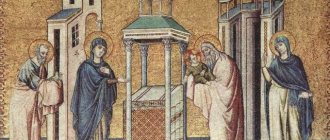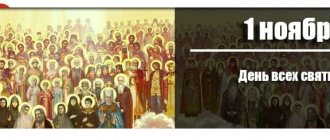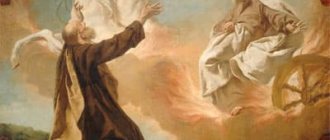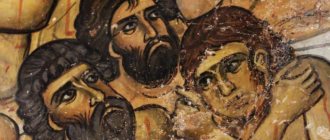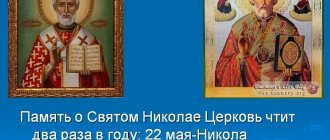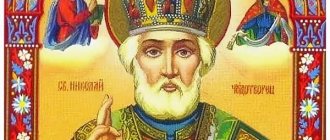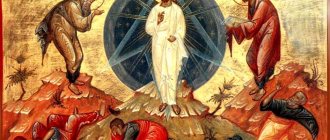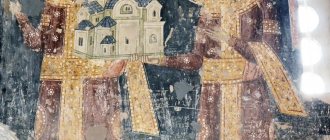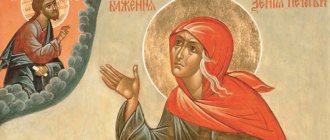Every year, for many centuries on the eve of Christmas, Christians celebrate the Holy Evening. The whole family gathers at the festive table, and the hospitable hostess brings out 12 dishes that symbolize the 12 apostles of Christ.
Christmastide begins on the night of the appearance of the first star in the sky on January 6 and continues until the morning church service on January 19.
There are three Christian holidays on these days:
- January 6 – Christmas Eve;
- January 7 – Christmas;
- January 19 – Epiphany of the Lord.
According to ancient tradition, on these days people rejoice, glorify Christ, visit relatives and give each other gifts. Let's find out in more detail what kind of holiday this is.
When is Christmas time in 2022?
"Good evening, generous evening,
Good health to good people!”
With these words people congratulate each other when they meet, wishing them health and prosperity. Christmastide marks the most unusual and mysterious time of the year. On this holiday, miracles happen and it seems that the whole world is shrouded in the energy of magic.
According to tradition, these days it is customary to rejoice: carnival fairs are held, people have fun, sledding and skating. On Holy Evening, unmarried girls tell fortunes about their betrothed.
According to the church calendar, Christmastide in 2022 begins on a fixed date - January 6 and lasts 12 days.
History and traditions of Christmas time
The Christian tradition of celebrating Christmastide dates back many centuries. The first mentions in history date back to the 4th century. 12 days after Christmas, people have fun and relax, glorifying the baby Christ. And only in 567, the church officially considered Christmastide to be a holiday.
These days it is customary to do charity work: visit hospitals and orphanages, help the poor and prisoners, give gifts and distribute treats.
Since ancient times, a tradition has appeared in Rus': young people dressed up in costumes of a bear, a goblin or a jester, went from house to house, sang Christmas songs - carols, schedrovkas and sowed. They glorified the hospitality of the owner of the house and desired wealth in the family. Congratulators were treated to sweets and given money.
Unfortunately, in our time, many people are confused about how correctly and on what day rituals for happiness, prosperity and well-being are carried out during the winter holidays.
Christmastide: how the demonic games of Russian youth took place
In the classic work “Paganism of Ancient Rus'” B.A. Rybakov points out that “ancient pagan incantatory and thanksgiving prayers” clearly appear in the system of Russian folk holidays. The Russian Orthodox tradition has absorbed the previous one.
Thus, we have lost the pre-Christian name for the summer solstice holiday: after all, “Ivan Kupala” is John the Baptist, who bathed Christ in the Jordan (the birth of John the Baptist was celebrated precisely on Kupala, June 24).
In the same way, Christmas on December 25 was located near the winter solstice, which in ancient times was the simplest mark of the beginning of a new annual cycle. With the spread of Christianity in European lands, the church, which wanted to suppress pagan cults, began to replace the holiday of the “Invincible Sun” celebrated on December 25 in the territories of the Roman Empire with the holiday of the Nativity of Christ around the 4th century. In this form, this tradition came to Rus'.
Karamzin wrote: “Yuletide games and fortune-telling seem to be a remnant of this pagan holiday” (meaning the holiday of the ancient deity Kolyada). During this festive period, falling in the middle of winter, ritual pagan entertainments were adopted, which, although the church branded them as “demonic games,” could not prohibit them.
Solstice Festival
Village life and its traditions were based on the agricultural cycle. Man needed the very measurement of time as soon as he moved from gathering and hunting to farming: the need arose to “time” when to start sowing fields, with what crops, when to harvest, etc.
Solstices and equinoxes are the most noticeable and easily measurable astronomical events, and in all cultures, including Russian, they were celebrated with radeniyas (mass ritual gatherings).
They had to appease the forces of nature and ask them for fertility and prosperity. The solstice and the period around it are a “time of transition,” when the world of the past year dies away and a new world is born. In this rift, otherworldly forces manifest themselves and allow one to communicate with oneself, so the holy weeks were of a ritual nature and were “equipped” with a system of rules and prohibitions. It was forbidden to work during the entire holiday season and especially on the eve of Christmas, New Year, Epiphany, and Epiphany. Women's work was considered especially dangerous: knitting, sewing, spinning. Sometimes on Christmastide the spinning wheel was even taken out into the hallway or hidden. The wood had to be chopped in advance, and the ax should not be taken into hand; During Christmas time it was necessary to pay off all debts, reconcile quarrels, get rid of unnecessary things in order to enter the new world clean and free.
All house cleaning work ended at lunchtime on the day before Christmas. Ritual food (porridge and bread) was placed on the table along with an unthreshed sheaf - products from last year's harvest, designed to attract a new harvest. During the Lenten meal, which began after the appearance of the first star, part of the food was “offered” to nature and spirits: jelly and kutya were put out on the street, and at night the food was not removed from the table - it was left for the spirits of ancestors.
After Christmas, the period of Yuletide ritual activities began. The main role in them was played by the village youth - after all, the prosperity of the community depended on the young people.
Activities “common” for men and women were: ritual walks around the area with songs and praises (caroling), dressing up as animals and folklore characters, and Christmas gatherings with paired games. An exclusively “male” entertainment was a fist fight - a symbolic sprinkling of the earth with blood, a sacrifice in the name of the future harvest. The girls had fun with fortune telling, mostly telling fortunes about future grooms - also a symbolic prayer for fertility.
Caroling
Bypass rituals, in the minds of the peasants, ensured the fertility of the fields, the offspring of livestock and protection from evil forces. In our tradition, such rounds are called caroling (the origin of the word “kolyada” has not yet been precisely determined). In ancient times, circumambulatory rites were performed under the leadership of priests (compare with a procession of the cross in a church), but even in carols, some participants in the rite (for example, a mekhonosh - a person who carried a bag for offerings, or a singer who set the tone for the chants) were considered “more important” than others.
Caroling took place several times during Christmastide: on Christmas Eve and Epiphany Eve, on Christmas morning and on the morning of January 1 - at the most “transitional” moments.
Subsequently, Christ-glorification was added to caroling: instead of cheerful ditties, young people sang troparia (short prayer chants) to the glory of Christ.
These two types of rounds coexisted, although the church sought to prohibit “demonic” caroling.
The content of carol songs is the most innocent: they are congratulations, wishes for happiness in the household and family life; It was not customary to refuse carolers. They were not so much begging for a treat as they were performing a magical ritual, in which the host-donors had to play a role if they wanted well-being in the future. They gave edibles: ritual cookies in the shape of animals, sweets.
Caroling is inextricably linked with mummering - dressing up carolers in the “guise” of animals and characters. In the first half of Christmastide (“holy weeks”) there were most “animal” faces: a horse, symbolizing the sun; bull or cow, symbol of fertility; bird, symbol of good news and the coming of spring. The outfits were simple: a leather or rag mask-mask and a sheepskin coat or fur coat turned inside out as a “skin” often made up the entire props. However, it was important to maintain anonymity; if the mummer was recognized by fellow villagers, he had to “leave the game.” The mummers became especially active in the second half of Christmastide (“terrible weeks”) - after the New Year and before Epiphany. It was believed that during this period evil spirits walked freely on the earth. Therefore, they dressed up as devils, kikimoras, and dead people, giving themselves a frightening appearance.
Long teeth made of rutabaga were inserted into the mouth, the face was smeared with soot, and a beard was attached from bast. Such mummers usually played pranks: they stole things, plugged chimneys with rags, propped open doors from the outside, stained door handles with manure, and scattered woodpiles.
Masking was perceived primarily not as entertainment, but as a function: men or young boys, sometimes lively women, but never unmarried girls and children, dressed up in “scary” masks. The mummers were chosen by lot, and after the end of Christmastide, everyone who dressed up in the “masks” necessarily swam in the ice hole on Epiphany in order to wash away their sins and start the year with a clean slate.
Gatherings
Gatherings, or parties, are a form of leisure for young people, led by the female half of village society. The gatherings differed according to the age of the girls, and at the “adult” gathering, young girls were received with initiation rites in the form of ritual songs or dances: “Some guy invites the intended girl to “go on a send-off.” She refuses. Then another guy comes up and, taking her by the arms on the other side, they begin to walk her along the floor (that is, in the center of the room) back and forth while the girls sing: “Let’s go walk around the floor, let God help you learn.” So the girl was introduced into the world.”
The main purpose of the gatherings was for the girl to find a couple (let me remind you that Christmastide is full of fertility rituals, and it is logical to come together at this time to start a family).
That is why guys from this or neighboring villages were welcome guests at gatherings. To “welcome” young people, before the get-together, the girls swept the path from the porch to the gate together, and when the guys came to the hut, they put a ladle in the oven “so they wouldn’t leave longer.”
New girls at the party sat at the entrance, and brides ready for marriage sat in the best places; they controlled the course of the gathering. The young people who came sat down with the girls, had conversations with them, and also showed off their prowess in dancing and group games. The guy called the girl he liked for a face-to-face conversation on the porch, and if there was mutual agreement, a couple was formed - now the guy became her “evening party.” It was not easy to reject the “evening party” - at least the girl who changed her mind had to pay him off with a very large sum for peasants (a ruble or more) or with an item - a tobacco pouch, a scarf, an accordion belt.
The gatherings were “supplemented” by shameful games - for example, by lot, girls sat on the guys’ laps or kissed them in turn. There were also tougher games, in which girls were grabbed by the soft parts, “testing” for fertility.
Well, the content of the ditties was such that inexperienced girls burned with shame.
Except during holy weeks, such erotic games were prohibited by village society, and dancing and singing songs were not particularly allowed. Married women or old men could keep order at gatherings, and they, like small children, could also be present at gatherings, so that excited youth would not allow themselves to be completely outright disgraced. The get-togethers ended well after midnight, when the “party people” went to see their girlfriends home - and then often walked around the village, causing a commotion for their neighbors.
Fortune telling and divination
Girls' fortune telling about their betrothed was definitely a “demonic” matter, but ineradicable. There were many types of fortune telling. They told fortunes in the barn - by randomly pulling out a piece of wool from the cattle that turned up, they determined what color the betrothed's hair would be. They told fortunes with yarn - they set fire to a ring of wool: if the ashes fly up, the future groom will come to the party today. They told fortunes in the bathhouse - they stuck their hand into the bathhouse (where, according to legend, the bannik lived - an unkind spirit) at night and waited for the bannik's touch: if the paw is bare, the groom will be poor, and the shaggy one will be a rich one (this type of fortune telling provided the village boys with an excellent opportunity to have a lot of fun with fortune tellers).
A common type of fortune telling was “sub-dish songs”. In this case, an object was placed in a dish or bowl, the bowl was covered with a scarf, and they began to shake.
All the girls at this time sang songs, each verse of which was somehow interpreted (“for good”, “for worse”, “for marriage”, “for death”, “they will take the groom as a soldier”, etc.). One by one, the girls approached the leader, who had a bowl in her hands, and tried to get an object (for example, a ring) out of it in one go. With whatever verse you managed to get him, that would be your fate.
Another very popular fortune telling has survived in our culture to this day in the form of the game “spinning the bottle.” On the floor in the hut where the girls' get-together was going on, they drew a circle, along its edges they designated village boys with letters or numbers, and then they put a spindle on its side and spun it - whoever the spindle points to will be the one to marry.
They also wondered about the harvest, health, prosperity, and so on. The “male” types of fortune telling stood apart, which were less common: for example, they threw a log on the floor with a flourish; the one who makes it ring louder, “the bride will be stronger.” There was an unambiguous subtext in this male fortune-telling: at night, near a pillar in the yard, a man put a tub of water and said: “Betrothed, come wash the pillar!” The future bride was supposed to appear in a dream that night. However, fortune telling was usually not a man’s business - men traditionally “performed” their magical functions during Christmas games and during fist fights.
Fist fight
Fist fights were a separate traditional male entertainment that took place since time immemorial and generally went beyond the scope of Christmas time. They started in late autumn. On Christmastide, Maslenitsa and Easter they fought especially often, and the battles were completely completed in June, on Peter’s Day.
Fist fights as a tradition were a guarantee of the minimum combat effectiveness of the country's male population.
Let me remind you that before the introduction of conscription by Peter I, ordinary soldiers of the Russian troops - peasants in ordinary life - were brought to training camps by the service landowners who owned their land. It turns out that for such an army, fist fights served as initial combat training.
The clergy, again, were against fist fights as “demonic fun.” However, when in the 40s of the 18th century the Holy Synod petitioned the government to universally prohibit “horses, wrestling, fistfights and other outrages,” the Senate decided that “such general fun on holidays free from work serve for public polishing, and not for what a disgrace."
The battles could last intermittently for a day or several days in a row, and the entire village district came running to “cheer.” Fighting was popular not only among peasants. Fans of fights in the 18th century were the Orlov brothers - Catherine’s favorite Grigory Grigorievich and his brother Alexei Grigorievich; It is known about the participation in the battles of the Moscow Governor-General, Count F.V. Rostopchin, who studied boxing in England. What can we say about ordinary nobles and representatives of other classes. When the battles took place in the cities, merchants, factory owners, officers came to watch... They placed bets, made bets, threw money into the crowd. It was considered prestigious for a merchant or factory owner to have a man “skillful with his fists” in his store or factory—competitions between factories, artels, and shopping arcades were not uncommon.
Fist fighting followed a few simple rules. There were two main types of combat - “meshed-dump”, when the two sides of the fighters mixed and fought in small groups, and “wall to wall”, when each side formed a dense row of fighters and converged with the enemy.
The battles took place in city squares, wastelands, but mainly in winter on the ice of rivers and lakes. The goal of the battle was to dislodge the enemy “wall” from the borders of the field - for example, from the ice to the shore.
The fight began with mutual bullying and comic insults, then groups of teenagers came together and started fighting. Older fighters (“outgrowers”), 16–18 years old, joined to support them. But this was only the “beginning”, after it there were already ranks of “grooms”, “singles”, who, having clashed, moved onto the “wings” of the “adults”, “married” following them. The age ranking was needed so that in battle the ranks of unequal opponents would not collide and there would be no obvious advantage. When the “adult” battle began, teenagers and “adults” left the battle or formed their own battle next to the main one.
Victory in a wall-to-wall battle was achieved not so much by force as by tactics: successful maneuvers, false retreats, surprise attacks.
Each “wall” had a leader who, the day before, determined the tactics of the duel with the most experienced fighters, and in the battle itself gave out instructions, determined the time and direction of decisive blows, commanded the change of ranks and the introduction of fresh forces. In difficult times, it was considered especially chic to bring strong men into the fray, “hopeful fighters,” who, dashing around their opponents, could cheer up their comrades who had already given up and inspire them to fight with renewed vigor.
Of course, there were well-known rules that made it possible to keep those fighting from committing suicide: 1) do not hit someone who is lying down; 2) do not hit spectators and passers-by; 3) you cannot put heavy objects in the mittens (even “our own people” were punished for violating this rule); 4) the fist is the only weapon (they didn’t fight with their feet, much less with objects); 5) it was impossible to “cross” to the enemy’s side. Malicious violators of these rules were expelled from the field and from fist fights in general.
The competitions took place intermittently from morning until evening; during breaks, beaten, bloody, swollen fighters talked peacefully with each other; It was customary for the fight to take place in a friendly, competitive atmosphere, where a successful, professional strike and technical victory were valued by both the winner and the loser.
Do's and Don'ts on Christmas Day
On Russian Christmastide it is customary to give gifts. Visit relatives and wish them health and well-being. It is believed that the more a person gives, the more wealth he will attract to the family.
On holy evening, it is customary to light candles in the house. People believe that the flame of a candle drives away evil spirits and attracts wealth and health to the home.
If there is a girl of marriageable age in the house, then they try to place her at the head of the table. This is a good sign for her to get married and be happy in her marriage.
The following actions are prohibited during Christmas time:
- On these holidays you should not wear old or torn clothes - the whole year will be unlucky.
- You shouldn’t remember or go to the cemetery - you might get sick.
- You can’t sweep out the trash or clean the house - you can sweep away the wealth and well-being from the family.
- You should not swear or quarrel - this will lead to separation or long-term hostility.
Divination
Yuletide rituals include fortune-telling, where, using some special signs, artificial or natural, they try to foretell the human lot and their future. In paganism, fortune telling was one of the main rites of worship; but when the pagans began to convert to Christianity, fortune telling began to be persecuted under the guise of divination, and if fortune telling remained among the people as a force of habit by right of prescription, then as a folk pastime the very word “fortune telling” is akin to the Hebrew word Gad, Gad - that was the name of the goddess happiness, and according to others, from the Sanskrit Gad - to explore, according to others - Gadam - to experience. Fortune telling in ancient times was a service to the goddess Gada (fortune, goddess of happiness). Based more on random but natural phenomena or signs, they discovered a secret, that is, they guessed something. Enchantment was the name given to the action of supernatural hostile forces to the harm of some or to the benefit of others, which is why sorcery, according to Stoglav’s interpretation, was called demonic service and had the same meaning as witchcraft, sorcery, which, according to legend, was practiced by the Chaldean and other sorcerers.
Methods of fortune telling can be natural or artificial, which are found not only among eastern peoples, but among the Greeks, Romans and Slavs. Yuletide fortune-telling is generally done in the evening or at night.
Signs for Christmas
- If the kutia for the holiday turns out to be boiled and tasty, then there will be prosperity all year.
- Frosty and snowy weather during the holidays foreshadows a hot summer and a good harvest.
- If there is a strong snowstorm on Christmas, the bees will swarm well and bring a lot of honey.
- There should be red wine and bread on the festive table - then there will be plenty for the whole year.
- If the first guest at Christmas is a drunk person, then soon there will be scandals in the family.
- An accidentally spilled drink at the holiday table will bring good news.
- A wedding on Christmastide is a sign of a happy marriage.
The meaning of Holy Days for Orthodox Christians
For many years the world awaited the coming of the Messiah. Not only the Jewish people, but also the pagan peoples awaited his coming. Archpriest Konstantin Parkhomenko says:
“50 years before the birth of Christ there lived the great Roman poet Virgil. In his famous Fourth Eclogue, he cites the prophecy of the Sibyls (in the Sistine Chapel in the Vatican, the brilliant Michelangelo depicted thoughtful women with scrolls. These are ancient pagan prophetesses - Sibyls). So, according to the prophecy of one of the Sibyls, a New Era is coming: a Baby will be born who will save people from their sins, who will destroy death.
In Ancient Persia there was also a teaching about the Savior of the world, who would free people from sin, who would resurrect all the dead and defeat Satan, the ancient dragon. Everyone: both Jews and pagans were waiting for a breakthrough, waiting for a way out of the current situation, when people did not have the strength to overcome sin, and such a way out appeared: Christ was born - the Savior of the world, and He brought them a New Teaching.”
Then the archpriest continues:
“The most important thing is that the born Christ brought salvation to the world. Having incarnated in our human nature, He took it upon Himself, died and then rose again, thereby showing that human nature, even if it is humiliated and trampled, can pass the path from earth to Heaven, to Eternal Life. This salvation extends to all who are united to Him. For everyone who entered the Church and became His disciple.”
The Almighty sent His Son into the world because He loved the humanity He created and did not want to leave it in perdition. Of course, with the birth of the Redeemer, the world did not become paradise, but the Lord showed how those who believe in Him can be reunited with their Creator. The path to the Heavenly Fatherland is paved by Love. Love for God and neighbor. And for this it is absolutely not necessary to create great things: you can do small things, but with great love.
What to cook for Christmas
Kutia and uzvar are considered symbolic dishes for Orthodox Christmastide. They are prepared by the main mistress of the house.
Kutya is cooked from various cereals or grains, with the addition of poppy seeds, nuts, raisins and honey. Grain symbolizes new life, and sweet fruit symbolizes a happy life. They treated guests with it and took it to their godparents.
Pancakes were baked for the festive table as a symbol of the reborn sun. Closer to midnight, the hostess put meat dishes on the table: baked goose with apples or suckling pig. Pies and pastries were brought out.
Spruce is a symbol of New Year and Christmas
By the same decree of December 30, 1699, Peter I ordered the main streets of Moscow, as well as the houses of noble people, to be decorated with coniferous trees and branches, and for the rest of the capital’s residents to install “a tree or a branch above the gate or above their mansion.” It was recommended to take the Christmas trees that stood in Gostiny Dvor as an example.
Residents were ordered to congratulate each other, light bonfires in the streets, shoot rifles and muskets, and set off crackers and fireworks. The New Year celebration lasted 7 days, and the main celebration took place on Red Square.
The first tree for the public was installed at Christmas 1852 in St. Petersburg in the building of the Ekaterininsky (now Moskovsky) station.
The fir trees were decorated and installed for Christmas on December 25, and they stood until the New Year or Epiphany on January 19. Despite all the efforts (and Peter I was very good at pushing through and introducing his favorite European traditions), people continued to consider New Year’s celebrations only as an addition to the Christmas ones. And the first Christmas tree decorations were therefore mainly on Christian themes - angels, stars, etc. And a star was always placed on the top of the tree as a symbol of the rising Star of Bethlehem.
The tradition was interrupted during the First World War. In 1915, German prisoners of war held a Christmas party in a hospital in Saratov, which caused an extremely negative reaction in the Russian press. After this, Emperor Nicholas II, fearing growing public discontent and rebellion, banned the installation of Christmas trees for Christmas.
